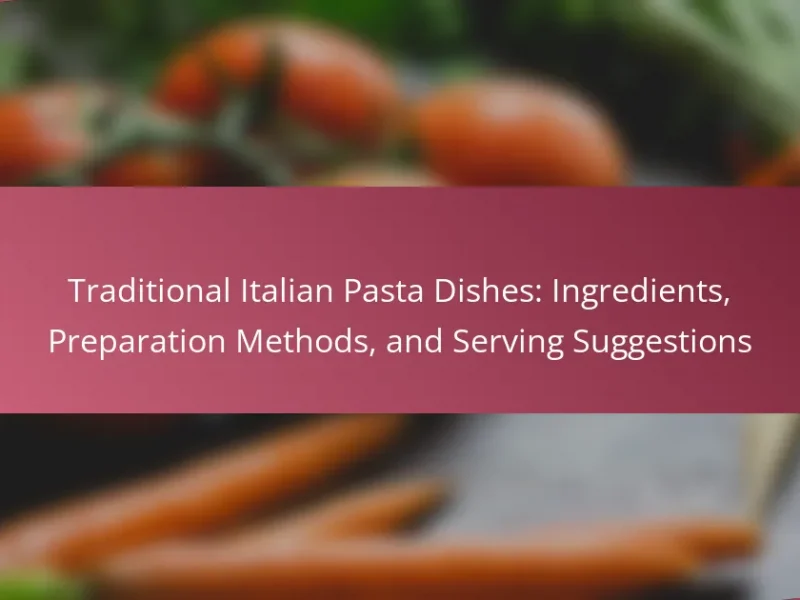The article focuses on Italian wine pairings, emphasizing the importance of regional compatibility, varietal characteristics, and food profiles. Key elements include matching wines from the same geographical area with corresponding cuisines, such as pairing Chianti with Tuscan dishes. It discusses how varietal characteristics influence flavor compatibility, highlighting examples like Barolo with rich meats and Pinot Grigio with seafood. The article also outlines practical pairing strategies, such as aligning the body and acidity of wines with the weight and intensity of dishes, to enhance the overall dining experience. Historical practices in Italy are examined to illustrate the evolution of traditional pairings that celebrate both wine and food.

What are the key elements of Italian wine pairings?
The key elements of Italian wine pairings include regional compatibility, varietal characteristics, and food profiles. Regional compatibility refers to pairing wines from the same geographical area as the cuisine. For example, Chianti pairs well with Tuscan dishes. Varietal characteristics highlight the unique flavors and aromas of each wine. For instance, a Barolo’s tannins complement rich meats. Food profiles involve matching the weight and flavor intensity of the dish with the wine. Light wines suit delicate foods, while robust wines match hearty dishes. These elements create harmonious pairings that enhance both the wine and the food experience.
How do regions influence Italian wine pairings?
Regions significantly influence Italian wine pairings through their unique terroirs and local cuisines. Each region in Italy has distinct soil types, climates, and grape varieties. For example, Tuscany is known for Sangiovese, which pairs well with hearty dishes like pasta with tomato sauce. In contrast, the Veneto region produces Valpolicella, complementing rich meat dishes and risottos. Additionally, regional culinary traditions dictate common flavor profiles, guiding wine selections. The coastal regions, such as Liguria, favor white wines like Vermentino, which enhance seafood dishes. Historical practices and local ingredients further shape these pairings, creating a deep connection between wine and food. Overall, the interplay of regional characteristics and culinary practices defines the art of pairing Italian wines.
What are the primary wine regions in Italy?
The primary wine regions in Italy include Tuscany, Piedmont, Veneto, and Sicily. Tuscany is renowned for its Chianti and Brunello di Montalcino wines. Piedmont is famous for Barolo and Barbaresco, made from Nebbiolo grapes. Veneto is known for Prosecco and Amarone della Valpolicella. Sicily produces a variety of wines, including Nero d’Avola and Marsala. Each region has unique climate and soil conditions that influence the wine’s characteristics. These regions contribute significantly to Italy’s reputation as a leading wine producer globally.
How does terroir affect the taste of wines from different Italian regions?
Terroir significantly influences the taste of wines from different Italian regions. Terroir encompasses the unique combination of soil, climate, and topography. In Italy, diverse terroirs contribute to distinct flavor profiles. For example, the volcanic soils of Etna produce wines with minerality and complexity. In contrast, the clay and limestone of Tuscany create wines with rich fruit flavors. The Mediterranean climate of regions like Puglia fosters ripe, bold wines. Additionally, altitude variations can affect temperature and sunlight exposure, impacting grape ripeness. Each region’s terroir shapes the characteristics of its wines, making them unique to their origins.
What varietals are commonly used in Italian wine pairings?
Chianti, Barolo, and Pinot Grigio are commonly used varietals in Italian wine pairings. Chianti, made primarily from Sangiovese grapes, pairs well with tomato-based dishes. Barolo, crafted from Nebbiolo grapes, complements rich meats and aged cheeses. Pinot Grigio, a white wine, is ideal for seafood and light pasta dishes. These varietals are staples in Italian cuisine due to their flavor profiles and regional origins. Each varietal enhances the dining experience by matching the flavors of traditional Italian foods.
What are the most popular grape varietals in Italy?
The most popular grape varietals in Italy include Sangiovese, Nebbiolo, and Barbera. Sangiovese is the primary grape used in Tuscany, particularly in Chianti wines. Nebbiolo is renowned for its role in Barolo and Barbaresco wines from Piedmont. Barbera is widely cultivated in the same region and is known for its fruity and low-tannin profile. Other notable varietals include Montepulciano, primarily found in Abruzzo, and Pinot Grigio, popular in the northeastern regions. Each varietal reflects the unique terroir of its growing area, contributing to Italy’s diverse wine landscape.
How do varietals impact food compatibility?
Varietals significantly impact food compatibility by influencing flavor profiles and aromas. Different grape varieties possess unique characteristics that complement or contrast with specific foods. For example, a high-acidity varietal like Sauvignon Blanc pairs well with rich dishes, cutting through fat. Conversely, a fuller-bodied varietal like Cabernet Sauvignon enhances the flavors of grilled meats.
Research indicates that certain varietals have historical associations with regional cuisines. Chianti, made from Sangiovese grapes, is traditionally paired with Italian pasta dishes. These pairings are not arbitrary; they stem from centuries of culinary practices. The tannin structure in varietals also affects compatibility. Tannins in red wines can soften with fatty foods, enhancing the overall dining experience.
In summary, varietals shape food compatibility through their distinct attributes, which interact with the flavors and textures of various dishes.
What factors determine food compatibility with Italian wines?
Food compatibility with Italian wines is determined by several factors. These include the wine’s acidity, tannin level, sweetness, and flavor profile. High acidity in wines pairs well with rich, fatty foods. Tannins in red wines complement protein-rich dishes. Sweet wines are best with desserts or spicy foods. The flavor intensity of the wine should match that of the dish. Regional cuisine also plays a crucial role in pairing. For example, wines from Tuscany often accompany hearty meat dishes typical of the region.
How do flavor profiles of wines match with different cuisines?
Flavor profiles of wines complement different cuisines through their acidity, sweetness, and tannin levels. For example, high-acid wines like Chianti pair well with tomato-based Italian dishes. The acidity cuts through the richness of the sauce. Conversely, sweeter wines, such as Moscato, enhance spicy Asian cuisines by balancing heat. Tannic red wines, like Barolo, match with fatty meats, as the tannins soften the meat’s texture. Each wine’s unique flavor attributes enhance or contrast with specific food elements. Studies show that proper pairings elevate the dining experience by harmonizing flavors.
What role does acidity play in pairing wines with food?
Acidity in wine enhances food pairing by balancing flavors and cutting through richness. High-acid wines complement fatty foods, such as creamy sauces or cheeses. This balance prevents the dish from feeling heavy on the palate. Acidity also brightens flavors, making dishes taste fresher and more vibrant. For example, a crisp Italian Pinot Grigio pairs well with seafood, enhancing its natural flavors. The acidity in the wine contrasts with the saltiness of the dish. This principle helps create a harmonious dining experience. Studies show that wines with higher acidity tend to be more versatile in food pairings.

How can one effectively pair Italian wines with food?
One can effectively pair Italian wines with food by considering the wine’s body, acidity, and flavor profile. For example, light-bodied white wines like Pinot Grigio complement seafood dishes well. Medium-bodied reds such as Chianti pair nicely with tomato-based pasta. Full-bodied wines like Barolo match rich meats like braised beef. Additionally, high acidity wines work well with fatty foods, cutting through richness. Italian wines often reflect regional cuisine, so pairing local wines with regional dishes enhances the dining experience. Historical practices in Italy show that traditional pairings have evolved to highlight the unique characteristics of both the wine and the food. This approach ensures a harmonious balance, enhancing flavors and overall enjoyment.
What are the basic principles of wine and food pairing?
The basic principles of wine and food pairing involve matching flavors and textures. Complementary pairings enhance both the wine and the dish. For instance, acidic wines balance rich foods. Tannic wines work well with fatty meats. Sweet wines can contrast spicy dishes effectively. The weight of the wine should match the weight of the food. Light wines pair with lighter dishes, while robust wines suit heartier meals. Regional pairings often reflect local cuisine and wine characteristics. These principles are grounded in the idea that balance enhances the dining experience.
How does the weight of a wine influence food pairing choices?
The weight of a wine significantly influences food pairing choices. Lighter wines complement delicate dishes, while heavier wines pair well with richer foods. For example, a light Pinot Grigio enhances seafood flavors. Conversely, a full-bodied Barolo matches well with hearty meats. This alignment creates balance on the palate. The concept of weight includes factors like alcohol content and tannin levels. Higher alcohol wines often feel heavier, influencing their compatibility with food. Research indicates that matching wine weight with food weight enhances the overall dining experience.
What are common pairing mistakes to avoid?
Common pairing mistakes to avoid include ignoring acidity levels. Pairing high-acid wines with rich foods can enhance flavors. Another mistake is mismatching weight; light wines with heavy dishes can lead to imbalance. Overlooking regional compatibility is also a mistake; local wines often pair best with local cuisine. Avoid pairing sweet wines with savory dishes, as it can create clashing flavors. Finally, neglecting personal taste preferences can lead to unsatisfactory pairings. Taste is subjective, and individual preferences should guide choices.
What traditional Italian dishes pair well with specific wines?
Pasta dishes like Spaghetti Aglio e Olio pair well with Pinot Grigio. The lightness of the wine complements the garlic and olive oil. Risotto, especially Mushroom Risotto, pairs excellently with Chardonnay. The creaminess of the risotto matches the richness of the wine. Tomato-based dishes, such as Marinara, are best served with Chianti. The acidity of Chianti balances the acidity in tomatoes. Grilled meats, like Osso Buco, pair well with Barolo. The tannins in Barolo enhance the flavors of the meat. Seafood dishes, such as Branzino, go well with Vermentino. The wine’s herbal notes enhance the freshness of the fish. Each pairing is rooted in regional traditions and enhances the dining experience.
Which wines complement pasta dishes best?
Red wines like Chianti and Barbera complement pasta dishes best. Chianti’s acidity balances tomato-based sauces. Barbera’s fruitiness enhances rich, creamy sauces. White wines such as Pinot Grigio and Verdicchio also pair well. Pinot Grigio’s crispness matches lighter pasta dishes. Verdicchio’s minerality complements seafood pasta. These wines enhance flavors and elevate the dining experience.
How do Italian wines pair with cheese and charcuterie?
Italian wines pair exceptionally well with cheese and charcuterie. The acidity in many Italian wines balances the richness of cheeses. For instance, a Chianti complements aged Parmigiano-Reggiano. The tannins in a Barolo enhance the flavors of cured meats like prosciutto. Sparkling wines, such as Prosecco, cut through the fat of creamy cheeses. Each region in Italy offers unique pairings based on local ingredients. This regional diversity enhances the overall tasting experience. The tradition of pairing wine with food is deeply rooted in Italian culture.

What are some practical tips for exploring Italian wine pairings?
Start by understanding the basic principles of wine pairing. Italian wines often complement regional dishes. For example, pair Chianti with tomato-based sauces. Explore different varietals like Barolo and Pinot Grigio. Match the body of the wine with the richness of the food. Light wines suit seafood, while robust reds work with red meats. Experiment with local cheeses and cured meats. Attend wine tastings to gain firsthand experience. Use food and wine pairing guides for reference.
How can beginners start their journey with Italian wines?
Beginners can start their journey with Italian wines by exploring the diverse regions and varietals. Italy has 20 wine regions, each offering unique flavors and styles. Beginners should start by tasting wines from well-known regions like Tuscany, Piedmont, and Veneto. Familiar varietals include Sangiovese, Nebbiolo, and Pinot Grigio. Visiting local wine shops or attending tastings can provide hands-on experience. Reading books or articles about Italian wines can enhance understanding. Joining wine clubs focused on Italian wines can also be beneficial. Engaging in food pairings will deepen appreciation for the wines. Pairing Chianti with pasta or Barolo with rich meats showcases Italian culinary traditions.
What resources are available for learning about Italian wines?
Books on Italian wines include “The Oxford Companion to Wine” and “Wine Folly: The Essential Guide to Wine.” Online courses are offered by platforms like MasterClass and Coursera. Wine tasting events are frequently held at local wineries and wine shops. Industry websites such as Wine Spectator and Decanter provide articles and reviews. Additionally, wine apps like Vivino offer user-generated ratings and information. These resources collectively enhance knowledge about Italian wines.
How can one develop a personal taste for Italian wine pairings?
To develop a personal taste for Italian wine pairings, one should start by tasting a variety of wines from different Italian regions. Italy produces diverse wines, each with unique characteristics. Exploring wines such as Chianti from Tuscany or Barolo from Piedmont can provide insights into flavor profiles. Pairing these wines with traditional Italian dishes enhances the tasting experience. For example, Chianti complements tomato-based pasta dishes well.
Attending wine tastings or classes focused on Italian wines can also help refine preferences. Engaging with knowledgeable sommeliers or wine experts can provide valuable guidance. Keeping a tasting journal to note preferences and experiences can aid in tracking evolving tastes. Experimenting with food pairings at home allows for personal exploration of flavor compatibility.
Over time, these practices will help in developing a nuanced understanding of Italian wine pairings.
What are some recommended Italian wine and food pairings to try?
Chianti pairs well with tomato-based dishes. The acidity of Chianti complements the acidity in tomatoes. Barolo is ideal for rich meats like braised beef. Its tannins balance the fat in the meat. Pinot Grigio works well with seafood, enhancing flavors without overpowering. Prosecco is excellent with light appetizers and fried foods. The bubbles cleanse the palate between bites. Sangiovese complements grilled vegetables, highlighting their smoky flavors. Each pairing enhances the dining experience, showcasing the harmony of Italian cuisine and wine.
Which Italian wines are best for special occasions?
Barolo, Prosecco, and Amarone are among the best Italian wines for special occasions. Barolo, known as the “King of Wines,” offers rich flavors and complexity. It is made from Nebbiolo grapes and ages well, enhancing its profile. Prosecco, a sparkling wine, adds a celebratory touch to events. It is light and fruity, perfect for toasting. Amarone, a full-bodied red, features dried grapes, resulting in a unique sweetness. Each of these wines complements various cuisines, making them versatile choices for celebrations.
What are some everyday Italian wine pairings for casual meals?
Everyday Italian wine pairings for casual meals include Chianti with pasta, Pinot Grigio with seafood, and Barbera with grilled meats. Chianti, a red wine from Tuscany, complements tomato-based dishes well. Pinot Grigio, a white wine, enhances the flavors of light seafood dishes. Barbera, known for its acidity, pairs nicely with rich grilled meats. These pairings are commonly enjoyed in Italy and reflect regional food traditions.
The main entity of the article is Italian wine pairings. The article explores key elements of pairing Italian wines with food, emphasizing regional compatibility, varietal characteristics, and food profiles. It discusses the influence of terroir on wine taste, identifies primary wine regions in Italy, and highlights popular grape varietals. Additionally, it outlines factors determining food compatibility, common pairing mistakes to avoid, and practical tips for beginners to enhance their understanding of Italian wines and their ideal pairings with traditional dishes.


